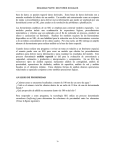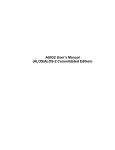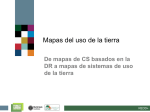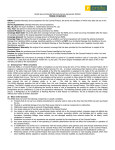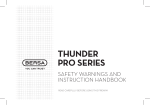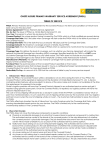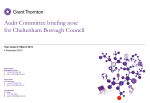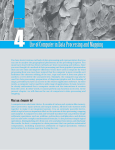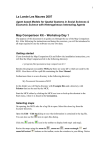Download Handbook for estimating the socio
Transcript
SECTION TWO: SOCIAL ASPECTS A GEOGRAPHICAL DATABASE A GIS maintains a database. The database concept is an essential part of a GIS and marks the main difference between it and simple drawing or computerized cartography software, which can only produce graphic information. Every modern GIS incorporates a database management system. This database may contain coverage, images, attribute tables, etc. A GIS links the spatial data with descriptive information about some particular feature of a map. The information is stored as attributes or characteristics of the element that is represented graphically. For example, a road network may be represented by road centerlines, in which case, a true visual representation would not provide much information about it. To obtain information about the road network, the user would consult the stored tabular data for roads, which might describe the class of roads, their width, type of surface, number of side roads, street names, and ranking. The user can then create a display that represents all the roads according to the type of information required (see the following figure). 64 SECTION TWO: SOCIAL ASPECTS A GIS may also use stored attributes to calculate new information about a map’s elements, e.g. the length of a given road or the total area of a particular kind of soil. Users who want to go beyond mere drawing need to know three things about each element stored in the computer: what it is, where it is, and how it is related to the other elements. (For example: which roads are linked to form a road network). Database systems deliver a means of storing a wide range of information and updating it without having to rewrite the programs every time that new data is input. In a GIS, the software handles the location of the elements, their descriptions, and the way in which each characteristic is related to the rest. A GIS allows the user to associate descriptive information with a map’s elements, create new relationships that can be used to determine the layout of different sites for development, assess environmental impact, calculate crop volumes, identify the best location for new facilities, etc. A GIS’s capacity for data integration makes it possible to look at and analyze data in powerful new ways. Users can access information in a database table from a map or they can create maps based on the information in the table. For example, they can select a municipality on a map and display a list with all the relevant information about its population. Going the other way, users can also create a map of municipalities and display each of them according to the number of children, adults, and old people in their populations. GIS COMPONENTS A GIS has several components: A GIS consists of hardware and software tools that use specific methods to perform operations on a database. The database is a simplification of the real world. The GIS user also becomes a vital part of the system when more sophisticated analyses are required. Sometimes, when queries about a place cannot be answered exclusively from the database screen, derived data may be required. Such derived databases are often the result of the effect of a model. A model is structured as a set of rules and procedures for deriving new 65 SECTION TWO: SOCIAL ASPECTS information that can be analyzed by a tool such as a GIS and used to assist in problem solving and planning. A GIS’s analytical tools are used to build spatial models. The models may include a combination of logical expressions, mathematical procedures, and criteria, which are used to simulate a process, predict an effect, or imitate a phenomenon. Making the models calls for the tools found in a GIS, the ability to choose and use the right ones, and great familiarity with the data being used. A GIS offers a great number of tools for analyzing the information in a spatial database. When users wish to make a query or review a theme related to a spatial phenomenon, they can use a GIS to derive new information by creating a model that performs the analytical procedures. They can then examine the results from the model. This process, which is known as spatial analysis, is useful for evaluating suitability and capacity, estimating and predicting, and interpreting and understanding. There are many kinds of spatial analysis in a GIS, including contiguity analysis, proximity analysis, demarcation operations, surface analysis, network analysis, and analysis based on the minimum element. These different forms of analysis include combined relational and spatial operations, as well as logical operations. PROXIMITY ANALYSIS How many houses are located less than 100 meters from a watercourse? How many customers live within a radius of 10 km of a given shop? What percentage of alfalfa is within 500 meters of the silo? To answer these questions, the GIS technology uses a process known as buffering, which determines the relationships of proximity between the elements (see the following figure). 66 SECTION TWO: SOCIAL ASPECTS LINKING ELEMENTS AND ATTRIBUTES As mentioned previously, the power of a GIS lies in the link between graphic (spatial) data and tabular (descriptive) data. They have three noteworthy features in this respect: • A one-to-one relationship is conserved between the map elements and the records in the element attributes table. • The link between element and record is conserved by a unique identifier assigned to each element. • The unique identifier is physically stored in two places: in the files containing the ordered pairs (x, y) and in the corresponding register in the element attributes table. A GIS automatically creates and conserves this connection. Combined relational operations As well as keeping the elements and their attributes up to date, the previously described concept can be used for other functions. Either of the tables can be connected provided they share an attribute in common. A ‘relationer’ uses a common item to establish temporary connections between the corresponding registers in the two tables. In a relation, each record in one table is connected to a record in another table that shares the same value for an item in common. A relation has the effect of making a table of attributes ‘larger’ by temporarily adding attributes to it, which are not really stored there. An example of this can be seen in the following figure. 67 SECTION TWO: SOCIAL ASPECTS A relation temporarily connects two attributes tables by using the item they have in common. In a GIS, a database that contains descriptive attributes can be joined to an element attributes table. If a relation is used, the file of related tabular data can be kept and updated separately. For example, the registers in tax files can be applied to a map showing plots of land, provided that each plot is identified with a unique number. Census data on land can be related with polygons using the number of plots of land contained in both. Combined spatial operations Relations and unions are among the basic operations of a GIS. They are simple in concept and are often used. For example, when a spatial superimposition is created, each new output element has attributes from the two sets of input elements used to create it. The superimposition of polygons is essentially a spatial union. In this case, instead of using a common item from two tables, the records are paired on the basis of the location of their associated geographical elements. 68 SECTION TWO: SOCIAL ASPECTS In the above figure, a coverage layer of populated centers is combined with layers for the hydrographic system, zoning, and relief. When these coverage layers are superimposed, the spatial information is combined, as are the attributes, and a combined coverage is produced. The possibilities of a GIS are based on its ability to carry out the many kinds of spatial analysis needed to answer the wide range of questions that people might have. A GIS can carry out all these operations because it uses geography or space as the common key between the data sets. Information is related only if it refers to the same geographical area. Like other information systems, a GIS confirms the truth of the saying that ‘better information leads to better decisions’. A GIS is not, however, an automated decision-taking system. On the contrary, it is a tool for analyzing, querying, and displaying geographical information that can be used to assist in decision-making. GIS technology is used to create scenarios that help us to take the best decision when solving a problem. Finally, it is important to mention that the development of personal computers has now brought GIS technology within the reach of everybody. A GIS now makes it possible to perform complex, sophisticated spatial operations with a desktop computer. 69 SECTION TWO: SOCIAL ASPECTS QUESTIONS THAT A GIS CAN ANSWER A simple GIS program, such as ArcView©, MapInfo©, IDRISI©, or GISMAP©, can be run on a PC to answer many of your location-related questions by making use of existing data. The following are examples of typical questions that a GIS can help to answer. Location: What exists in …? The first of these questions attempts to discover what exists in a particular location. A location can be described in many ways. For example: place name, postal code, or geographical references, such as latitude and longitude. Condition: Where … ? The second question is the opposite of the above and requires spatial analysis before it can be answered. Instead of identifying what exists at a given location, you may wish to find a place where certain conditions are met (for example, a non-forested piece of earth with an area of at least 2,000 square meters, 100 meters from a road and with soil that is suitable for building). Trends: What has changed since …? The third question, which might include the first two, attempts to find differences within an area over a given period of time. Patterns: What spatial patterns exist? This is a more complicated question. You might ask it to find out whether cancer is the leading cause of death among people living near a nuclear power station. Or just as important, you might want to know how many anomalies from a pattern there are and where they are located. Creating models: What would happen if …? ‘What would happen if …?’ questions are asked to find out things such as what would happen if a new road were added to a highway system or if a toxic substance were to be introduced into the underground water supply system. Specific geographical and other information is needed to answer this type of question. 70 SECTION TWO: SOCIAL ASPECTS The questions included when creating models call for the generation of additional data (using a complete GIS, such as ARC/INFO), based on existing geographical data. The following are some typical question-asking techniques. Proximity: What are the characteristics of the area around the existing elements? Provide a summary of the types of vegetation to be cleared within 100 meters of a fire cutoff for a high-voltage power line; inform the fire brigades about the nearest watercourse at the time of fighting a forest fire; notify the owners of wells within three miles of a toxic waste dumping site of possible pollution; warn all owners within 500 meters of a proposed change of site. All these problems can be solved with the proximity analysis tool: generation of intermediate memory areas or calculations of ‘intra-characteristic distance’. Limiting operations: What exists within a specific region? Examine a problem, test a hypothesis, and define alternative courses of action for the prototype areas in order to apply a model to an entire area of interest. You will sometimes wish to create data for specific areas of study. The limit operation tools can separate specific areas or they can extract elements from within a particular area. Logical operations: What is unique for a region or a set of elements? Examine soils with a particular alkalinity; study roads built with a specific kind of surface, study wells that are deeper than their design depth. The answers to some questions about spatial elements can be found in their tabular attributes rather than their location. Elements can be extracted from databases or introduced into them by using logical operations. Spatial union: Where is something? Establish area division discrepancies; establish wildlife habitat requirements; determine which parts of a right-of-way fall inside land whose ownership is in dispute. Many questions can be answered with spatial union operations, which are often referred to as the “superimposition of polygons”. Spatial union operations provide new elements for the existing attributes. 71 SECTION TWO: SOCIAL ASPECTS NOTES ON USING ARCVIEW© A spatial database may contain information about natural phenomena, artificial characteristics, limits, properties, etc. ArcView is a utility that creates an onscreen environment and queries the contents of a spatial database. ArcView allows users to explore the database, show all or part of its contents, query, and display or save results and feed information to graphic and other applications. THE ARCVIEW INTERFACE The ArcView interface consists of windows, menus, tool bar, and status bar. Like all programs that run under Windows, ArcView is driven by menus that are activated by selecting options or clicking on icons. It is also extremely intuitive and user-friendly in its operating sequence. ArcView’s main window is the applications window. All ArcView operations are executed from there. This window can be resized, minimized, and maximized with the mouse. To load and display a coverage, an ArcView project must first be created, since every working session is saved in projects (file extension .apr). A project contains all the views, tables, graphics, cartographic compositions, and macros that you need for a given application. This means that all your work is saved in the same place. The projects window organizes and lists the contents of the active project and makes it easier to manage and control work. A new project will be named ‘untitled’ until given a new name. See the figure below. 72 SECTION TWO: SOCIAL ASPECTS The tool bar is just below the men bar. The icon buttons are used to activate given functions immediately without having to access them through a menu option. When the cursor passes over an icon on the tool bar, a description of its function appears in the bar at the bottom of the screen. At the start of an ArcView session, the main applications window contains only two buttons: one to save a project, the other to access the online help. As one works with ArcView, the tool bars at the top of the screen change according to which window is active (a view, a table of attributes, graphics, etc.). 73 SECTION TWO: SOCIAL ASPECTS The following figure is a screenshot of several buttons grouped together. Each set of icons or buttons is used to activate different functions. For example, the tool bar in the second row beneath the main menu is used for operations that you might want to carry out on a map displayed in a view: request information about an element in the map, select an element, edit vertices, select a set of elements, zoom in and out, pan, measure, etc. TYPES OF ARCVIEW DOCUMENTS Boxes, tables, diagrams, schemes, and macros handled in ArcView are known as documents. Each kind of document is briefly described below. Views A view is an interactive map that displays, explore, queries, and analyses geographical data. A view defines how the geographical data you are using will be displayed, but does not itself contain the geographical information. 74 SECTION TWO: SOCIAL ASPECTS A view can be thought of as a collection of themes. A theme is a collection of geographical phenomena defined by the user. The previous figure shows the view titled ‘View 1’, which shows the Punta Arenas sector in Region XII of Magallanes. The view has a table of contents (or legend), which lists the themes being reviewed. The components of the view can be determined by looking at the table of contents. In the figure above, the window displays and lists the contents of the view. Table of Attributes Tabular data are stored in a table. You can display, query, and also analyze almost any kind of tabular data, such as geographical aspects, types of soil, road conditions, etc. Graphs Graphs allow the user to show numerical information in a graphic form. A graph makes it possible to visually compare the behavior of one variable with that of another. ArcView provides several options for creating graphs that can accompany the display of attributes in a map. 75 SECTION TWO: SOCIAL ASPECTS Cartographic compositions Cartographic compositions allow users to locate every type of document in a single window and produce a final map. Instead of being copied directly, views, tables, and maps can be referenced within a cartographic composition. In this way, changes to any of the elements are automatically reflected in the composition. You can add elements (titles, legends, bar scale, texts, arrow to indicate North, etc.) to the cartographic composition. Macros A macro is a set of commands written in the language known as ‘Avenue’ that allows users to manage the database in ArcView transparently. You can use ‘Avenue’ to design your own interface to access ArcView. 76 SECTION TWO: SOCIAL ASPECTS All documents are managed through the project control window. Each type of document is represented by an icon, which, when selected, will display a list with the documents of this type that exist in the project. REPRESENTATION OF ELEMENTS ON THE MAP Geographical phenomena are represented in the database by geometrical elements like polygons, lines, or points. The geographical phenomena are known as classes of elements: • Polygons might, for example, represent plots of land whose rateable value is within a certain range or parts of forests that contain particular species. • Lines might represent paved roads, paths, or drains of a specific diameter. • Points might represent the location of warehouses, customers, wells, or significant places. AN ARC/INFO© COVERAGE A coverage is a digital version of a map. It is the basic object that stores the geographical data (geographical elements and their attributes) in ARC/INFO©. A coverage may contain one or more classes of geographical elements. For example, a coverage whose elements are areas or polygons also contains labeled points that identify each polygon. In addition, a coverage containing polygons that represent plots of land may also contain linear elements (arcs) that contain information on the boundaries between the plots. When we add ARC/INFO© coverage to a view, the class of element to be used can be chosen. ARCVIEW PROJECTS A project is a space (with an .apr extension) that ArcView creates so that you can organize your work and documents in one place (or file). A project makes it easy to maintain and manage any combination of interrelated ArcView components. Views, tables, maps, cartographic compositions, and macros can all be worked on and saved simultaneously in one file. When you create an ArcView project, you create a file that contains the views, maps, plans, and documents that make up the project. 77 SECTION TWO: SOCIAL ASPECTS THEMES IN A VIEW ArcView uses geographical information from a variety of databases to display a given geographical characteristic or theme in a view. Examples: spatial databases, including ARC/INFO coverage, configured ArcView files, and satellite image data. ArcView also supports tabular (alphanumeric) databases that contain geographical information, such as street addresses and X,Y coordinates. The definition of the theme might simply be a request to display the complete database referred to in the theme, or it might be a set of criteria applied to the database to identify which part of the data should be displayed. A database is an ARC/INFO coverage or an image file. The image may have been scanned or it may come from a satellite. Themes can be given any name. A theme might be named according to the database to which it refers. For example, USENOW (present use of land), P3716 or COV143. It might also be named according to the criterion that it meets. For example, ‘Appropriate areas for development’, ‘Soil code = 5’, or ‘Model 2 results’. Each theme represents a set of geographical elements that have a given characteristic or attribute. This characteristic or attribute is reflected cartographically by means of a determined symbology that is shown in a legend. A legend controls the way in which the elements in a theme are drawn. It consists of symbols. These symbols might be patterns that fill an area, types of lines that trace a linear feature, or marks that show the specific location of a point (see following figure). 78 SECTION TWO: SOCIAL ASPECTS The symbols can be drawn with a great variety of colors. A theme can be displayed by using the same symbol and a different color or vice versa. For example, all the roads can be drawn with a broad red line or shopping centers can be represented with a yellow flag. For this purpose, ArcView provides a color palette (see following figure). Since a theme is derived from a geographical database, themes generally contain geographical elements associated with a table of attributes. All the elements of a theme can be drawn on the basis of a particular attribute value. For example, each 79 SECTION TWO: SOCIAL ASPECTS tap water pipeline can be drawn in a different color or with a different thickness according to its diameter if diameter is an attribute of the linear elements that represent pipelines. Elements can be classified and then symbolized in accordance with the classification scheme, or each unique value for an attribute can be drawn. For example, types of soil can be shaded according to their alkalinity; regions can be colored according their net migration figures; or plots of land can be shaded with a unique pattern or color according to existing holdings. As you get used to ArcView, you will learn how to use the table of contents to control which themes are visible. It is possible to display all or just some of the themes on one screen. You can also control the order in which the themes are displayed. Each theme points to a coverage stored in a database somewhere in the system. The data can be stored on a local disk or on a disk in a network. Although many themes can be derived from the same coverage, an individual theme can only refer to one attribute of that coverage. Although a theme can contain only one class of element (polygon, line, point, or text), it can be derived from a coverage that has more than one type of element. For example, a coverage formed by censused city blocks (polygons) and the fronts of each block (lines) has a topology for the polygons and the linear elements, but the theme based on this characteristic can only display one of them. Another theme can be created to display the attributes of the other class of element. TABLE OF ATTRIBUTES Spatial databases (e.g. ARC/INFO©) have a table of attributes which is associated with the geographical elements and which contains information describing them. When a theme is displayed in a view, a table of attributes is immediately associated with the displayed elements (polygon, line, point, or text). 80 SECTION TWO: SOCIAL ASPECTS If you have numerical information in an external file (in dBase, INFO, or comma or tab delimited ASCII format) that is related to the elements displayed in your view, it can be added to your ArcView project like any other table. These files generally contain additional information on the elements displayed in a view. It is also possible to create a table in ArcView to enter information interactively. We have given basic information about ArcView operation and document handling. For a more detailed explanation of the program’s functions and operations, see the User’s Manual for ArcView 3.0. 81 SECTION TWO: SOCIAL ASPECTS THE ROLE OF ARCVIEW IN SPATIAL ANALYSIS As mentioned previously, ArcView© is a display and querying tool that can carry out many tasks included in the spatial analysis of ARC/INFO© geographical databases. ArcView can be used with more than one coverage or database. Since display and query are essential for interpreting the results of spatial analyses, ArcView complements the spatial analysis carried out in ARC/INFO©, by making it possible to investigate the results and new spatial relationships derived from analytical procedures and models previously made with ARC/INFO©. 82



















